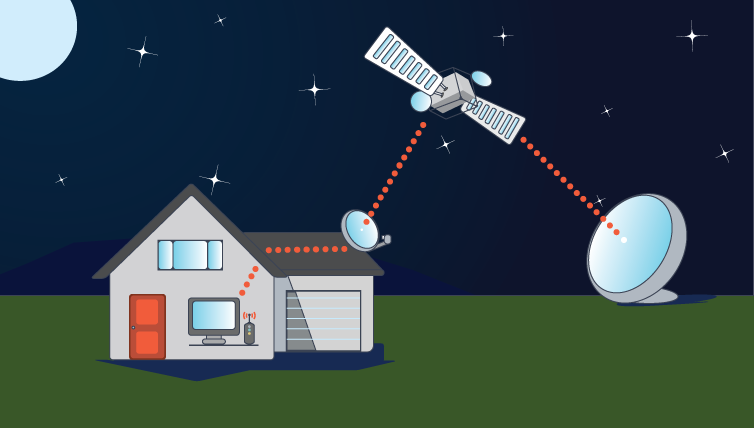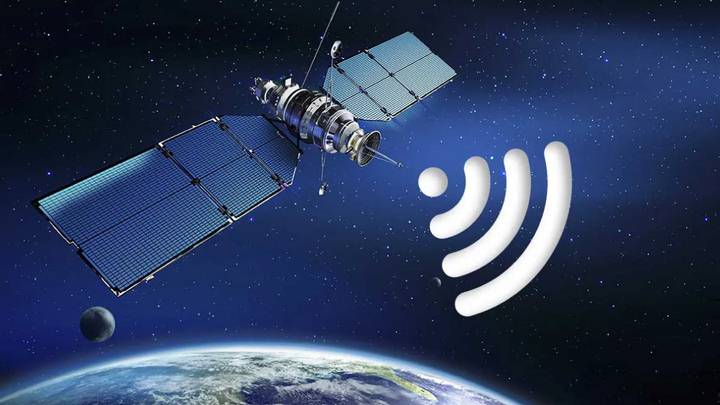Satellite Internet in Morocco is a new high-speed Internet satellite solution in Morocco to meet the growing needs of Moroccan individuals and professionals. The solution offers an unrivaled Internet experience in terms of connection quality thanks to the satellite.
For all those excluded from broadband (end of xDSL line, forgotten about 4G, etc.), satellite internet access represents a possible alternative. On the other hand, it is not always easy to find your way in the jungle of offers – it is an understatement – and conditions. Before taking the plunge, here are the things to know.
In Morocco, an overwhelming majority of residents benefit from Internet access via xDSL, fiber optic or cable, but not everyone can take advantage of it in good conditions. Until 2022 or better days, the satellite appears to be a solution to take into account in order to obtain “good speed”.
In the last census, at the end of 2017, less than 100,000 subscribers subscribed to it, very often because it was the only solution. Because this technology is not without imposing some limits: current offers do not exceed 30 Mb / s (theoretical maximum), have quota, have a significant ping, require equipment and a clear view, etc.
The opportunity for us to make a great comparison of what the different operators offer and the conditions they impose on their customers. But before that, let’s start with a few reminders on how this solution works.
Two problems: very high latency, shared bandwidth
Satellite subscriptions are all based on the same principle: the customer must install a satellite dish in his home, which is then used to send and receive data via a satellite. For its part, the satellite connects to a transmitting station on the ground, itself connected to the Internet.
In practice, when you seek to access a site, your request is transmitted by your satellite dish, which sends it to a ground station and the latter takes care of retrieving the page. The station then sends the data back to the satellite, which transfers it to your satellite dish so that it finally arrives on your computer … a journey of more than 140,000 km each time you request it (around 3.5x around the Earth).

One of the main problems with the satellite stems directly from this (very) long journey: very high latency. It takes at least 240 ms for a signal to go back and forth between Earth and the satellite. Indeed, those used for the Internet are geostationary (that is to say, they are always in the same position in the sky) and are located at approximately 36,000 km above sea level. 240 ms represents the time necessary for the light to cover the 72,000 km round trip.
The minimum latency is therefore around 500 ms (two round trips), but in practice the average is rather around 700 ms according to the different ISPs. While this does not usually pose too many problems for surfing, the same is not true for network games and other remote desktop solutions, which require a weak ping.
Moreover, satellite ISPs generally explain that they advise against their offers for uses such as network games. Another important point to take into consideration: the satellite bandwidth is shared between all users and is not infinitely expandable. We are not only talking about subscriptions for individuals, but also professionals and television services that use a satellite.
ISPs therefore explain that the theoretical maximum speed can be lowered when the satellite is heavily used by all customers. The companies that manage the satellites have also put in place a “fair use policy” in order to prevent that the speed can be limited in case of high demand.
The data is often limited, sometimes with “fair use”
Thus, there are almost no unlimited offers, with one exception – SkyDSL – but at the price of strict conditions and sometimes very difficult to understand (we will come back to this). As a result, the packages offered by ISPs for the general public generally vary between 2 and 100 GB (download and upload included).
Some ISPs, on the other hand, do not deduct your consumption at night (generally between 0h and 6h). This period can for example be used to download games or updates of several GB and thus consume a significant part of your package.
If some operators cut the connection once your quota is reached, others opt for a different approach with “fair use” – that is to say a reduced speed – exactly as in mobile telephony. A majority sells recharge packs with additional GB.
In short, you will have to pay according to your use, which is generally not the case on landlines in France.
Three satellites above our heads
ISPs can currently only rely on three satellites covering all or part of metropolitan France. They act as distributors with commercial agreements with one or more satellite managers like Eutelsat, SES and Avanti, which do not offer direct subscriptions to the general public.
Launched in 2010 and operational since 2011, KaSat by Eutelsat is the main satellite providing Internet in France. It offers a total bandwidth of more than 90 Gb/s. Individuals can obtain speeds of 22 Mb/s in reception and 6 Mb/s in transmission. But it is (almost) saturated.
To the point that Eutelsat had stopped marketing consumer offers for a year in a third of the country, before relaunching them. It largely covers the old continent and is accessible everywhere in mainland France and Corsica.
For its part, SES launched the Astra 2F satellite in September 2012. It is not only dedicated to satellite Internet in Morocco and also offers television services. The speeds for individuals are 20 Mb/s in reception, but only 2 Mb/s in transmission. Again, it covers all of mainland France.
Finally, a last operator launched at the end of 2016: Avanti, via its Hylas 2 satellite. This allows you to climb up to 30 Mb / s in downloads and only 2 Mb / s in uploads, but it does not cover all France. About a third of the metropolitan area is eligible (mainly in the east). A coverage map is available on the c2m website (Avanti subsidiary), the only operator to market subscriptions via Hylas 2 in France.
Either way, satellite Internet service providers usually don’t let you choose which satellite to use. You usually need to do an eligibility test to find out more details about your home.
A THD in preparation, a SpaceX constellation in ambush
The next generation is preparing at Eutelsat with KONNECT VHTS: “With a mass of 6.3 tonnes and with a capacity of 500 Gb/s in Ka band, KONNECT VHTS will embark on board the most powerful digital processor ever put into orbit, capable of combining flexibility in the allocation of capacity, optimal use of the spectrum and progressive deployment of the ground network”.
Eutelsat gets carried away in its press release: “Over the next decade, VHTS satellites will provide capacities to serve large-scale markets for air connectivity and very high speed Internet, offering a service comparable to that of fiber, both in terms of price and speed ”… ignoring that whatever the power of the satellite, it will always be limited by the speed of light. The latter implies a latency of half a second whatever happens … we are far from fiber optics.
Other companies are trying a different approach. This is the case of SpaceX with its Starlink constellation (read our analysis) of nearly 12,000 satellites placed in orbits between 335 and 1,325 km. The latency melts like snow in the Sun passing from 500 ms to 16/17 ms, but it is necessary to be able to synchronize the satellites turning around the Earth. At this altitude, they are no longer geostationary. This project is only in its infancy and only two test satellites have recently been in place.
The necessary equipment, its cost and financial aid
Who says satellite necessarily says satellite dish for the transmission / reception of data. It will therefore be necessary to buy or rent the necessary equipment. The costs are significant since several hundreds of euros are involved in a purchase.
However, as recently recalled by the Senate, “more than half of the departmental councils have set up financial aid for the installation and/or for the acquisition of the reception kit”. They are however subject to “various procedures, which does not facilitate the legibility of the system” recognizes the Luxembourg Palace.
The operators offer maps to know what you are entitled to depending on your department. You will find information on the C2M website to name just a few. In any case, do not hesitate to approach your local community to find out what exactly it is.
ISPs also offer to rent equipment for 1.99 to 9.90 euros per month. If this rental is interesting on paper, be aware that there are generally additional costs (activation, commissioning, etc.) which are added during subscription, with a commitment sometimes longer.
You must, therefore, take into account all the parameters when choosing the offer that interests you.
The details of the conditions? Move along, nothing to see…
While on fixed and mobile offers, operators must offer standardized information sheets gathering all the conditions, with an organized presentation, we have almost never found any concerning offers by satellite. And when they were, not all the details were necessarily given.
To know the restrictions, the costs of commissioning and all the other little subtleties, it is therefore necessary to spend time searching the nooks and crannies of the sites… when this information is displayed and / or easily understandable. In short, on the satellite, the information to customers is (very) far from clear and it is a shame.
We questioned the Fraud Prevention (DGCCRF), to find out if satellite Internet service providers were subject to the same obligations as those on landline and mobile. No answer yet. In any case, it is a pity that the authorities allow this to happen, even more excluding these rural subscribers from market standards.




